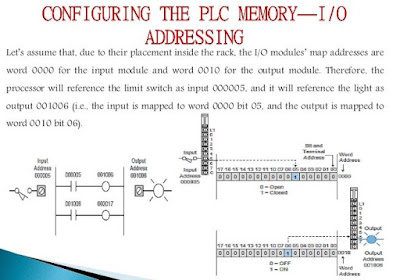MEMORY SIZE
PLCs are available with memory sizes ranging from as little as 256 words for small systems up to 2 Meg (million) for the larger systems. Memory size is usually expressed in K values: 2K, 4K, 16K and so on. K actually stands for 1000 but represents 1024 because the numbering systems used with PLCs is binary system, We use every day that is base 10.
While it is common for PLCs to measure their memory capacity in words, it is important to know the number of bits in each word. A PLC that uses 8-bit words would have half the memory capacity of a PLC that uses 16-bit words. For Example, the PLC that uses 8-bit word has 65,536 bits of storage with an 8K word capacity (8*8*1024 = 65536), whereas a PLC using 16-bit words has 131,072 bits of storage with the same 8K memory. It is important to know the word size of any given PLC before memory size can be accurately compared.
The actual size of the memory required depends on the application. In the event that future expansion is planned, there are two options: Buy a PLC with more memory than is presently necessary to allow for future expansion: or buy a PLC that meets present needs and add memory when the need arises.
MEMORY ORGANISATION
For PLC to function properly and control a process it must be able to perform the user program repeatedly, accurately and speedily, which is achieved by processing all information in binary signals. Binary information has only two states: 1 and 0 (ON or OFF, HIGH or LOW, TRUE or FALSE). There is nothing in between state or condition.
THE PROCESSOR MEMORY
It consists of hundreds or thousands of locations that are referred as words. Each word is capable of storing binary data in the form of binary digits (1 or 0). The number of bits that a word can store will depend on the system of PLC. Words can be made up to 32 bits, 16 bits or 8 bits. The 16 bit word is the most common.
ADDRESSING WORDS
In the memory serves the same function as the addresses used for homes or apartments. For example, Word 100 represents a specific word location in memory just like N100 Lincoln represents the address of an apartment building. The bits in word 100 are found by referencing a given bit number, just like the occupant of the apartment complex is found by a given apartment number. Since a bit of information can only be a 1 or 0 (ON or OFF). How is the status of bits within a word determined? Words that store the status of individual bits for input devices are set to 1 (ON) of 0 (OFF) depending upon the status of the input devices that the bit location represent. Other bits are set to 1 or cleared to 0 by the processor in response to the logic of the user program, RELAY LADDER LOGIC, or special instructions, which in turn controls the status (ON or OFF) of other bits that represent output devices.









No comments:
Post a Comment